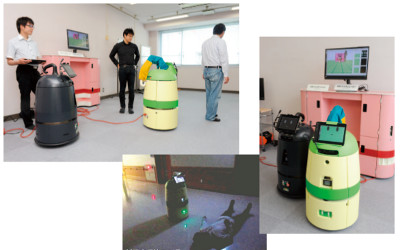Top
/ Laboratory


Index
- Laboratory : Introduction of the SybLab
- Laboratory / Research Topics : Introduction of research topics
Human Machine Symbiosis Laboratory
- Considering a mechanism for humans and robots to grow together -
We study symbiotic ways of human-machine behavior and development, where robots learn behaviors from humans and humans grow with robots. It is important for humans to be motivated by activity in order to live. If robots can inspire us and motivate us, we would be grateful. For example, when a patient is doing rehabilitation training in a hospital, if a robot learns the training conditions and leads the patient well, it may motivate us to train and focus more on rehabilitation. In addition, in order to perform this kind of work, the robot must have its own body. Having the robot in front of you as an entity gives you the opportunity to touch and talk to it. When humans and robots share the same space and time, they can act together and feel safe.
The Human Machine Symbiosis Laboratory builds robots and interfaces and brings them to nursing homes and hospitals to evaluate their functions and discover new needs through demonstration tests. Recent technologies in the laboratory have made it possible for robots to follow and watch over elderly people with dementia, and to detect the state of movement and speech to inform facility staff of the situation. In the future, we hope that robots will be able to take on the isolation and anxiety of humans. However, it is not yet clear how to do this. How should humans and robots communicate and cooperate with each other, and moreover, how can humans and robots grow together and develop each other? Join us on a research journey to explore the symbiosis between humans and robots.
(From the booklet of laboratory introduction partially revised)

Human Machine Symbiosis Laboratory
laboratory head: Ryo Saegusa

|
His main areas of expertise and research interests are in the symbiosis and evolution of humans and machines, including nursing-care medical support robotics, body augmentation interfaces, machine learning and cognitive developmental systems, and sensory-motor integration and sensory information processing. He is the author of “Ageing and Digital Technology” (co-author, Springer). He commercialized a nursing medical concierge robot in 2019 through industry-academia-government collaboration. [Biography] | [Contact] |
